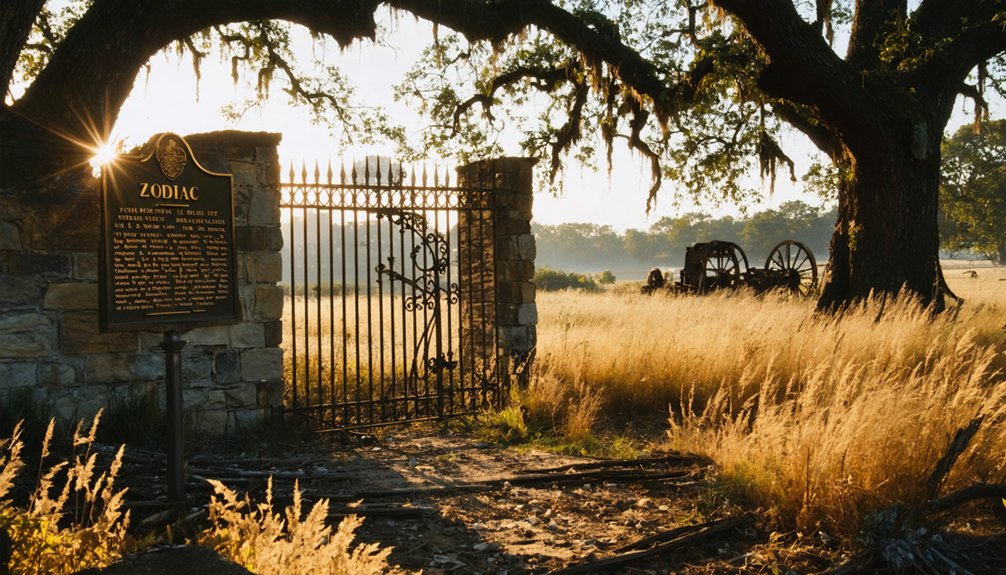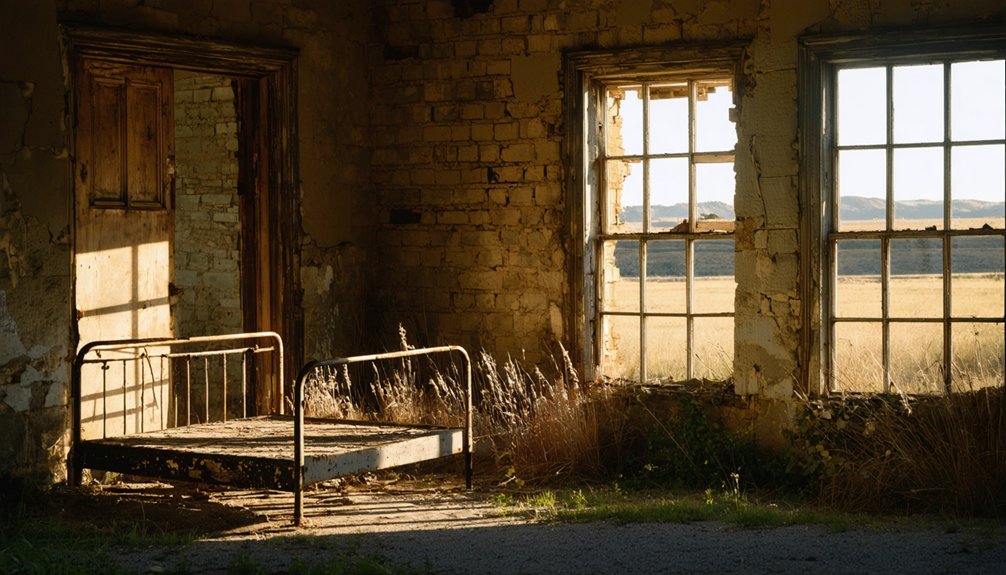You’ll discover Zodiac’s ghostly remains along the Pedernales River in Texas Hill Country, where Mormon leader Lyman Wight established a thriving settlement in 1847. The community of 150-200 pioneers operated successful mills, farms, and a trading post until devastating floods struck between 1851-1853. While no structures stand today, a 1936 granite marker off Schmidtzinsky Road commemorates this pioneering settlement’s brief but influential role in shaping early Texas commerce and agriculture.
Key Takeaways
- Zodiac was a short-lived Mormon settlement established in 1847 by Lyman Wight along the Pedernales River in Texas.
- The settlement featured essential structures including a gristmill, sawmill, and tabernacle, supporting 150-200 Mormon pioneers.
- Severe flooding between 1851-1853 destroyed the settlement’s economic foundation, leading to its eventual abandonment.
- No original structures remain today, but a 1936 Texas historical marker off Schmidtzinsky Road commemorates the ghost town’s location.
- During its brief existence, Zodiac was a prosperous community that supplied lumber and agricultural products to nearby Fredericksburg.
The Mormon Settlement’s Birth on the Pedernales River
After Joseph Smith’s death led to a schism in the Mormon Church, Lyman Wight and his followers established the settlement of Zodiac in 1847 along the Pedernales River, just four miles southeast of Fredericksburg, Texas.
The Mormon migration that brought them to this spot wasn’t direct. You’ll find their path wound through Grayson County’s Mormon Grove, where they wintered in 1845-1846, before moving to Austin.
There, they contributed their labor to various projects, including jail construction, while searching for their ideal settlement location.
The group’s journey through Texas Hill Country finally led them to the Pedernales River site, where 150 to 200 settlers found the water resources they needed for farming and milling. Like the ancient Babylonian astronomers, they used careful observation of the night sky to help guide their travels and timing.
This first Mormon colony in Texas represented Wight’s vision of establishing a new Zion. The settlement quickly grew to include skilled craftsmen and artisans, with wheelwrights, blacksmiths, and carpenters establishing vital trades.
Life in Early Zodiac: A Pioneering Community
If you’d visited Zodiac in its prime, you’d have found a bustling community of 150-200 Mormon pioneers working together under Lyman Wight’s “common stock principle” of shared labor and resources.
You’d have seen residents tending to their farms along the Pedernales River, which provided essential irrigation for their crops, while others operated the settlement’s crucial gristmill and sawmill.
The community’s daily rhythm centered around the tabernacle, where religious gatherings strengthened their unique Mormon faith, and the storehouse, which supplied settlers with their basic needs. The settlement represented an important chapter in Texas Mormon history, as documented in detailed historical records. Many of these settlers later relocated to Bandera County, where they established themselves as successful ranchers and merchants.
Daily Mormon Pioneer Life
While the Mormon pioneers of Zodiac embraced a unique communitarian lifestyle, their daily routines centered around shared labor, religious devotion, and mutual support.
You’d find these hardworking settlers tending to their farms, operating the community’s crucial mills, or trading with neighboring settlements. Their religious practices shaped every aspect of life, from worship in their newly built temple to the “common stock principle” that governed their shared resources. Under the leadership of Lyman Wight, the settlement maintained strong organizational structure and unity.
At the community store, you’d witness the exchange of locally produced flour, lumber, and other essential goods. Despite pioneer challenges like floods and political tensions, they maintained a thriving school, supported nearby German settlers with agricultural expertise, and contributed to regional development projects. The settlers earned respect from their neighbors by helping construct Fort Martin Scott nearby.
Their industrious spirit exemplified the determination of America’s frontier religious communities.
Water and Agriculture Systems
Life in early Zodiac revolved around three essential water sources: natural springs, seasonal creeks, and human-made irrigation systems.
You’d have witnessed the pioneers adapting Spanish irrigation techniques like acequias to combat water scarcity in the harsh Texas climate.
Your survival in Zodiac would’ve depended on mastering these critical agricultural practices:
- Constructing small dams and cisterns to capture and store precious water during dry spells
- Implementing efficient irrigation techniques borrowed from Spanish and Native American traditions
- Maintaining a delicate balance between crop farming and livestock needs through strategic water management
The pioneers learned from the first municipal water system established by Spanish settlers in 1718, adapting similar irrigation methods for their own community.
Much like the families displaced by Toledo Bend Reservoir, the early settlers had to carefully plan their lives around available water resources.
You’d have faced the constant challenge of unpredictable weather patterns, where droughts could suddenly give way to flooding.
These conditions shaped every aspect of daily life, from crop selection to the community’s spatial layout.
Lyman Wight’s Vision and Leadership
After Joseph Smith’s martyrdom in 1844, Lyman Wight claimed a divine mandate to establish a mission among Native Americans in Texas. His vision directly challenged Brigham Young’s authority, as Wight insisted that Smith had specifically called him to lead this Texas initiative.
Wight’s vision and leadership style shaped Zodiac’s founding as a religious and communal experiment. As a former apostle and Mormon militia leader, he directed 150-200 followers to settle near Austin in 1845-46.
You’ll find his influence reflected in the settlement’s organization, from the establishment of mills and furniture factories to his role as second chief justice of Gillespie County.
Despite opposition from mainstream LDS leadership, Wight remained fiercely independent, leading his “Wightites” until his death, when many followers joined the Reorganized Church.
Daily Routines and Economic Activities
You’ll find the daily life in Zodiac centered around its agricultural heartbeat, where Mormon settlers tended to cotton fields, processed grains, and maintained livestock from sunrise to sunset.
The community’s mills along the Pedernales River served as essential economic engines, processing lumber and grinding grain for both local use and trade.
Fredericksburg proved an important trading partner, with Zodiac’s residents exchanging their agricultural products and milled goods through the settlement’s central storehouse system.
Daily Agricultural Practices
Three distinct agricultural phases shaped daily life in Zodiac: the Mormon communal farming period of 1847, the slave-operated cotton plantation era, and the post-Civil War period of diversified farming.
You’d find a mix of crop rotation and livestock grazing practices that evolved with each phase, adapting to the Hill Country’s unique conditions.
Daily farm operations typically included:
- Cotton cultivation and harvesting, particularly intensive during the plantation period
- Subsistence farming of various crops, supported by seeds and flour trading
- Animal husbandry, including cattle raising and horse management for farm work
If you’d visited during the Mormon period, you’d have seen cooperative farming methods, while the plantation era brought slave labor-intensive cotton production.
After the Civil War, the area shifted to more diverse agricultural practices under German, English, and Danish settlers.
Mill Operations
Standing as a demonstration to Mormon ingenuity, the three-story Mormon Mill dominated Zodiac’s industrial landscape from 1851, its massive twenty-six-foot waterwheel powered by Hamilton Creek’s year-round flow.
You’d find skilled laborers managing both gristmill operations and sawmill processes, transforming local grain and timber into essential products for the region. The mill’s wooden dam controlled water flow, ensuring steady power for grinding wheat and sawing lumber throughout changing seasons.
If you’d visited the mill, you’d have seen a bustling trade hub where farmers brought their grain and collected flour, while craftsmen secured lumber for furniture-making and construction.
The mill’s products reached markets as far as Austin, though mounting debts eventually led to its closure in 1901 before fire claimed it in 1902.
Trade With Fredericksburg
Beyond the mill’s operations, Zodiac’s settlers fostered a dynamic trading relationship with nearby Fredericksburg that shaped both communities’ growth.
The trade dynamics centered around a storehouse they built, which served as a crucial commercial hub for exchanging goods with Fredericksburg residents and Fort Martin Scott.
Their economic contributions included:
- Supplying essential building materials like shingles and lumber for Fredericksburg’s infrastructure
- Providing agricultural products from their 2,217-acre communal farms, including corn and flour
- Crafting furniture and other goods needed by the growing settlement
You’ll find their trade routes were protected by the Meusebach-Comanche Treaty, allowing safe passage for goods between communities.
This economic partnership thrived until 1853, when flooding destroyed Zodiac’s mills, greatly impacting their production capacity.
The Settlement’s Brief but Impactful Existence
Although Zodiac’s existence lasted only four years, this Mormon settlement left an indelible mark on Texas Hill Country’s development.
Despite settlement challenges, you’ll find that this industrious community quickly established a prosperous agricultural base and critical infrastructure, including a sawmill and gristmill that served the entire region. Their community resilience shone through as they supplied essential building materials to Fredericksburg and Fort Martin Scott while creating a well-organized society with New England-style hospitality.
Nature ultimately decided Zodiac’s fate when severe flooding between 1851-1853 destroyed their indispensable mills, forcing the community to disperse.
Yet their legacy endures through their contributions to early Texas infrastructure, farming innovations, and the establishment of Fort Martin Scott – achievements that earned them a Texas Centennial marker in 1936.
Modern-Day Legacy and Historical Recognition

The 1936 placement of a gray granite historical marker off Schmidtzinsky Road marked Texas’s official recognition of Zodiac’s lasting influence.
This enduring granite marker stands as Texas’s acknowledgment of Zodiac’s pioneering spirit and historical legacy.
Though you’ll find no standing structures today, the settlement’s historical significance lives on through preserved records and community heritage.
While the site remains on private property, limiting public access, you can still trace Zodiac’s impact through:
- The maintained historical marker that commemorates the 1847 Mormon settlement
- Fort Martin Scott’s development, which the settlers helped construct in 1848
- The economic contributions they made through lumber, furniture, and agricultural production
You’ll find Zodiac’s story woven into the broader Texas narrative, representing frontier perseverance and showcasing the diverse religious and cultural influences that shaped the Lone Star State.
Exploring What Remains: A Historical Journey
When visiting Zodiac’s historic site today, you’ll find yourself standing on private property where a once-thriving Mormon settlement shaped Texas frontier life from 1847 to 1851.
You’ll discover a Texas Historical Landmark marker off Schmidtzinsky Road, commemorating this unique example of cultural exchange between Mormon settlers and German colonists.
While the original chapel, mills, and school have vanished, you’re walking the same grounds where remarkable environmental impact shaped the settlement’s fate.
The devastating Pedernales River flood of 1851 destroyed the community’s economic foundation, forcing residents to abandon their homes.
Even the settlement’s cemetery, where founder Lyman Wight was buried, has been lost to time – plowed over and stripped of its markers.
Frequently Asked Questions
What Happened to the Original Mormon Settlers After Leaving Zodiac?
You’ll find these Mormon settlers faced significant migration challenges, establishing Mormon Mill in Burnet County, while others dispersed throughout Texas or joined different Mormon communities after Wight’s death in 1858.
Were There Any Conflicts Between Zodiac Settlers and Nearby Native American Tribes?
Through blood-stained prairies and burning homesteads, you’ll find records of violent settler interactions with Comanche and Kiowa tribes near Zodiac. Both sides engaged in raids, horse theft, and territorial disputes.
What Specific Crops and Livestock Were Raised in Zodiac?
You’ll find cotton was the primary crop, with supplemental grain farming for flour production. While specific livestock management details aren’t clear, settlers likely practiced crop rotation and raised cattle typical of Hill Country.
Did Any Non-Mormon Settlers Live in or Near Zodiac?
While non-Mormon settlers lived in nearby Fredericksburg and surrounding areas, you wouldn’t have found them within Zodiac itself – it was exclusively Mormon under Lyman Wight’s leadership until abandonment in 1851.
How Did Weather Patterns and Natural Disasters Affect the Zodiac Settlement?
You’ll find weather dealt harsh blows to Zodiac, with the most devastating being the 1851 Pedernales River flood that destroyed essential mills. Drought impacts aren’t well documented, but flood consequences forced Mormon settlers’ departure.
References
- https://alchetron.com/Zodiac
- https://www.stoppingpoints.com/texas/sights.cgi?marker=Site+of+Zodiac&cnty=gillespie
- https://www.historictexas.net/city/zodiac-texas
- https://www.chron.com/life/travel/article/Texas-ghost-towns-sure-to-5820152.php
- https://www.hmdb.org/m.asp?m=251813
- https://www.wikiwand.com/en/map/Zodiac
- https://texashistory.unt.edu/ark:/67531/metapth61101/
- https://www.texasescapes.com/TexasHillCountryTowns/Zodiac-Texas.htm
- https://atlas.thc.texas.gov/Details/5171010133/print
- https://en.wikipedia.org/wiki/Zodiac



